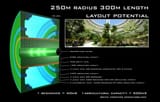>>23447073
>>23447074
Somebody get both a physicist and a structural engineer over here. A rotational habitat will experience similar forces, but with an o'neill cylinder, with the amount of surface area inside, it's far more like hanging platform supported rails along the edges. A o'neill cylinder is filled with air and this means it's is not just like a suspension bridge, it's like a suspension bridge that is also a pressure vessel. A suspension bridge does not need to deal with the internal pressure like it's a can of air nor the amount of surface area nor deal with air pressure the same way as this can of air. Suspension bridges are most deucedly not firm - they can be be constructed firm, the strongest building materials at these dimensions are relatively yielding, even tearing themselves apart when wind is strong enough. That is not reliably inhabitable. You also overstate the amount of maintenance and if more durable materials would last longer especially if it's in an area difficult to replace or repair. You also overstate the effect of this thicker mass because the cylinder is mostly hollow by design anyway and imply adding mass will compromise it when other designs like the kalpana add layers anyway for structural stability or add support hulls. You talk about energy and expenses needed but by the time we can build o'neill cylinders, even as cheap as possible, the cost of power is assumed to be negligible because building a cylinder hab is so extensive that these extra costs are extra drops in a bucket. We would need nuclear fusion or some space based solar collectors just to make it possible in the first place so if energy's the problem, we wouldn't get off the ground.
TL:DR The o'neill cylinder would face forces like a suspension bridge but also enough problems a suspension bridge doesn't. Air alone could mean tons per m^2. It's oversimplified. Also some of these alleged problems are small time if we could build an o'neill cylinder in the first place.
